Shetland Islands 2015
Lerwick to Lunna - Sunday, 28th June
The boat was steaming north in fine weather as the 6.00 am wake up call did its job. I was on the wrong side to see much but I imagined we'd be navigating the south Shetland coastline towards Bressay Sound. I had my complimentary continental breakfast in the Magnus Lounge, cereal, muesli, cappuccino, fruit, yoghurt, croissant and toast. Back in the cabin, I changed into cycling gear and put my 'normal' clothes in the spare bag ready for the return journey. The ferry manoeuvred into place on its ramp.
Drivers were called at 7:30 am. I grabbed the bags and made my way down to the main car deck. It wasn't full and I only waited a short time for the cars and camper vans to move off before being waved off the boat. I coasted through the car park and round to the terminal on the left. I deposited my spare clothes bag in the terminal left luggage room and put the water bottles in their cages.
On the way to Lerwick, I went a bit wrong at a roundabout and ended up in Garthspool at a dead end. I recovered the route and found North Road again and continued on to the Esplanade.
The annual Bergen to Shetland yacht race had reached Lerwick that weekend and I was looking forward to seeing the yachts in the harbour. Lerwick town centre was eerily quiet but the harbour was full, the scene dominated by the jazzy monochrome bulk of the flotel 'Sans Vitesse'. |
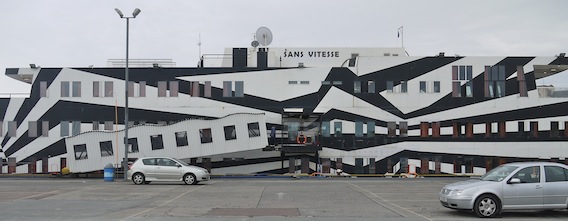 |
There was a rope across the car park entrance with a guy turning people away, so I cut down the side, cycled across the empty car park and propped the bike up against a barrier.
|
 |
Apart from the Sans Vitesse, there was what I took at first sight to be a blue cruise liner moored at the end of the dock. The 'Ocean Atlantic' looked pretty old and unloved and it dawned on me that it too must be floating accommodation for gas construction workers. There was a tall ship next to it, the 'Frederyk Chopin' registered in Szczecin. A group of people were gathered at the back.
|
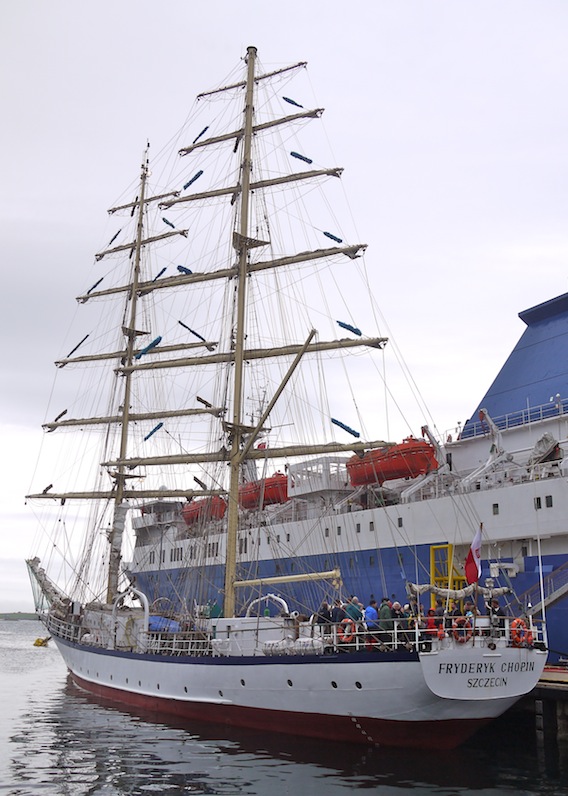 |
The Norwegian yachts were moored in the harbour. There wasn't much activity, then again it was still early.
|
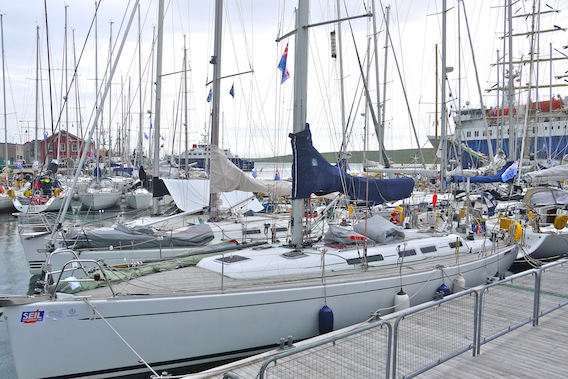
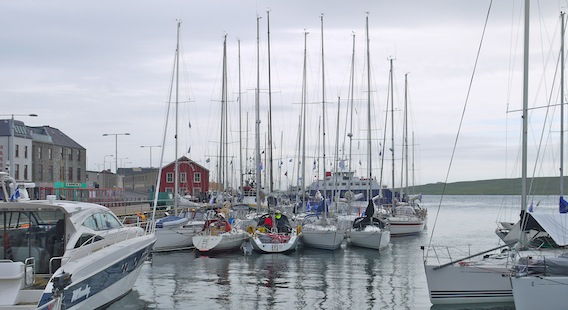 |
I rolled out of the car park and re-traced my route back to the ferry terminal. My weather app predicted a band of rain arriving from the south west around midday. The sky was becoming ever more overcast but at least the wind was in the right direction.
Just after the ferry terminal, I turned left following the sat nav up Gremista Brae and rounded the corner into Ladies Drive. I met the A970 down to the Scalloway turning near the Golf Club and stopped at the bus stop for a first rest. At the top, I turned off left down the hill into Veensgarth and continued on towards Tingwall Airport turning right at the junction with the A971. A short run took me back to the A970.
I'd decided to take a few detours and the first one was a loop through Laxfirth and back round by the Loch of Vatster. Back again north on the A970 through Girlsta, the next detour was to take the coastal route around South and North Nesting, along the B9075 which arrived on the right after the Loch of Girlsta.
This is a very pleasant route that avoids the main north south traffic. Cat Firth opened up with fine views across the water to Litle Holm. A little further on I stopped at the shop, which was closed. |
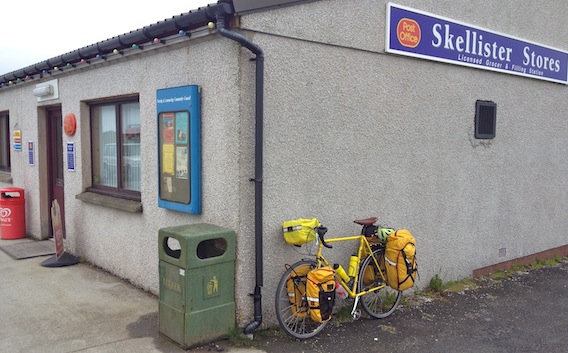 |
The weather was deteriorating and the heralded rain seemed imminent. I took the opportunity to put on my overshoes and neck draft excluder which I pulled up over my ears.
South Nesting is really picturesque, with the road passing between the Lochs of Freester and Houlland and over to the sea again with the small beach at West Voe of Skellister. South Nesting Bay then opens up with lovely coastal views. Someone once told me that this was a good spot for seeing orcas, and I kept out a watchful eye.
The road starts to turn inland at Brettabister where I stopped to take a look at the imposing Nesting war memorial. The sheep were using it for shelter against the strengthening wind. |
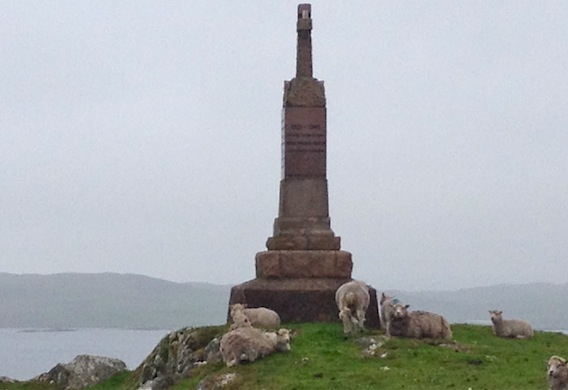 |
A fairly stiff climb followed up Kirk Ward with a summit at 91m by Loch of Bellister. I propped the bike up by a gate, took a long swig on a bottle and marvelled at the view.
|
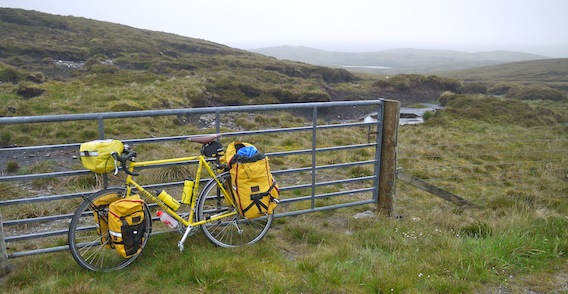 |
Whilst the cloud was thickening all the time, the view from this position is outstanding both out to sea and onwards to North Nesting.
|
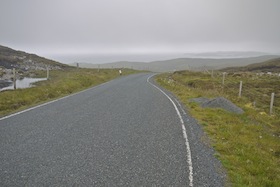
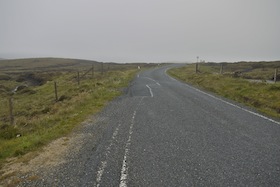 |
The descent was fairly eye-watering into Grunnafirth Burn valley and over the little bridge. I briefly glimpsed the Whalsay ferry in the Voe. The road then emerges on the south side of Dury Voe and follows the contours around to the B9071 at Laxo.
I turned right hoping to find a bus shelter because it started to rain and the southerly wind now blasted my right side. With no shelter in sight, I continued past the Whalsay ferry terminal and so started on roads not previously travelled. The Cabin Museum was on the left, identified by a sign attached to a small building on the right. This I judged would be as good a shelter as any and I stopped for lunch. |
 |
With the rain whistling round both sides of the shed, I found the food bag and ate a meal consisting of pate on rye bread, biscuits and orange juice. With neck draft excluder pulled back over my ears and everything strapped back down, I ventured forward into the maelstrom.
A short while later the road turned northwards with some relief as the wind hit my back. In no time at all I crossed over a small rise and arrived in Vidlin, where there was a bus shelter, outside the shop. I stood inside it dripping whilst the rain hammered on the perspex. |
 |
I considered going into the shop for more supplies and perhaps some warm food. Several cars came and went before a lull in the rain allowed a foray across the car park. I bought some chocolate for later, a banana, a pint of milk and a chicken pie which the nice man microwaved for me. I ate this heartier meal in the bus shelter whilst hoping for the weather to improve.
If anything it was getting worse as each wave of darker cloud advanced smartly across the moorland followed by a curtain of intense rain. Eventually I decided to brave the elements and carry on to Lunna, which the road sign declared was only 3 miles away. |
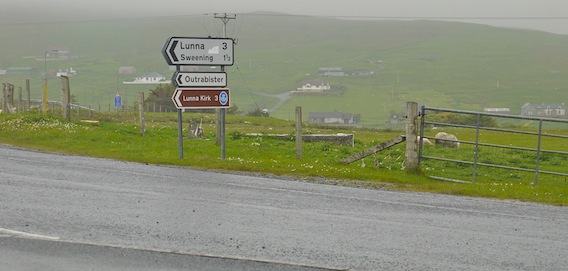 |
I don't remember too much of the three miles as with head down, I just ploughed on into the mist. The road climbed a little up the side of Vidlin Voe, then dropped to reveal Lunna House set on the other side of the narrow strip of land between West and East Lunna Voes. I stopped briefly to survey the scene which was the location of the wartime Shetland Bus operation.
The rain was bouncing down. I dropped down the hill to Lunna Kirk and stopped by the entrance for a mooch. This is the oldest church in Shetland that's still in use and there seemed to be a service underway, so I didn't stop very long. I cycled up the hill around Lunna House and found the entrance round the side. There was no sign of life so I unhitched the gate and cycled round to the front of the house. By the side of the door was the plaque I was looking for. |
 |
Leif Larsen was a Norwegian sailer who's arguably the most famous of those who participated in the Shetland Bus operation and the most highly decorated. The plaque made the enterprise described so wonderfully in Howarth's book, seem very real. Looking out into the Voe, in the mist and rain, in this isolated location, only added to my sense of admiration for those who worked under what must have been very challenging circumstances.
I'd used Google Earth to look for a likely camp site beyond the end of the road, as far as possible with a bike. Ideally this would have been towards the end of Lunna Ness, possibly on the south side depending on the wind. In the event, all I wanted to do was find a sheltered spot, pitch the tent, get out of the rain and dry off.
Shutting the gate behind me, I continued on up the hill. The road topped another crest and there was a nice view of the rest of Lunna Ness, down to Boatsroom Voe with the Ayre of Hamnavoe reaching out. I sped down the hill, rounding a few bends then dropping down to sea level past the entrance to the fishing service base.
In search of a camping spot, I cycled up through Hamnavoe and then noticed an abandoned croft on the left a little further on. This was a fairly extensive site with a number of ruined buildings set in a mosaic of fields, with what looked from the road like some level green grass. The croft must have supported a good number of people.
After a quick reconnoitre, I settled on the top corner of a grassy field near to the main building. My Terra Nova Laser Large tent has two long sectional poles for the roof plus a solid pole for each end. These end poles are a pain because they're too long to pack away with the tent as they make the tent bag too big for the panniers. My solution is to carry them separately, fastened to the rear bike rack with elastic bands. Worse is that they're tricky to fit into their little elasticated pockets, which is not helpful when trying to errect the tent quickly in the rain. I put the de-bagged bike in a sheltered corner inside the old croft.
I soon realised that this was an excellent sheltered spot with fine views north past Linga, Fish Holm and Samphrey, with Mossbank on the left and Burravoe on Yell on the right. |
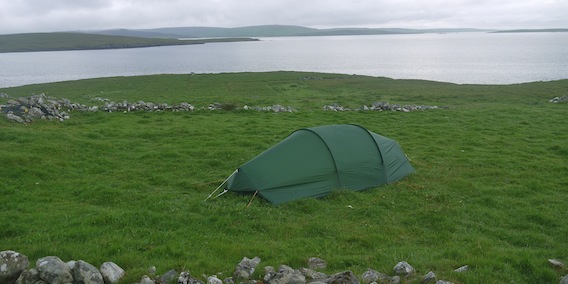 |
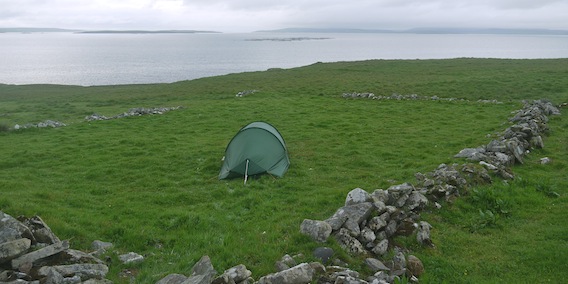 |
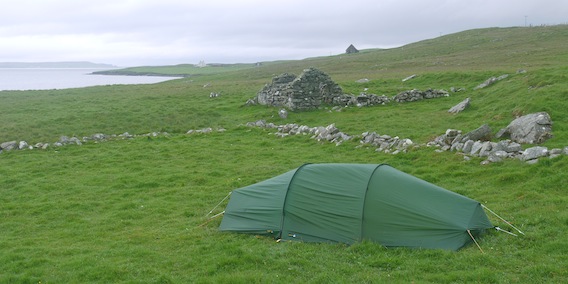 |
From time to time I saw the ferry plying its trade between Toft and Ulsta.
|
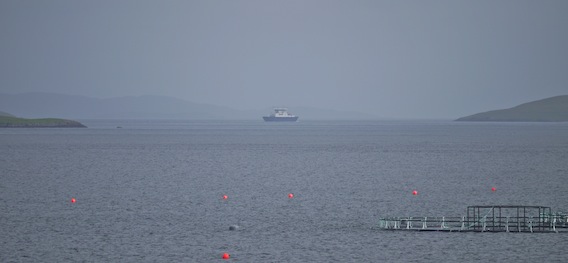 |
With everything eventually in the tent, I put on some dry clothes and instantly felt the benefit. A cup of tea and a biscuit later, I was ready to explore my new surroundings. In between the rain showers, I wandered around, had a mooch down by the sea and inspected the other buildings.
My new Alpkit gear I have to say, worked amazingly well. The little stove together with the heat-exchanger-equipped brupot, managed to boil water in quick time. With the tea brewed in the kelvin insulated bug, my MRE roast beef with vegetables boiled away merrily in its bag. The pipedream sleeping bag had fluffed up nicely and together with my thermorest, promised a good night's sleep.
Later, the sky became interesting. Venus and Jupiter were set to become very close in a few days, however the cloud cleared just at the right time to allow a nice view of the planets. |
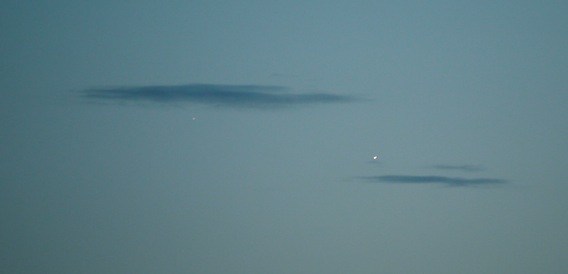 |
As I sipped my Azera latte coffee, I contemplated the Universe from my peaceful position and marvelled at the wonderment of it all. The sun dipped down behind clouds at the horizon and my whole view was filled with a magnificent big big sky.
|
 |
Whilst contemplating the probable harsh realities of crofting in this landscape, the moon crept up over my left shoulder and shone brightly in a blue sky over the croft.
|
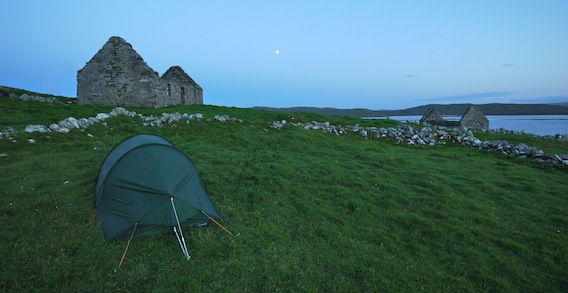 |
The moon rose higher and one of the fish service boats was caught in the moonlight, reflected in the Voe.
|
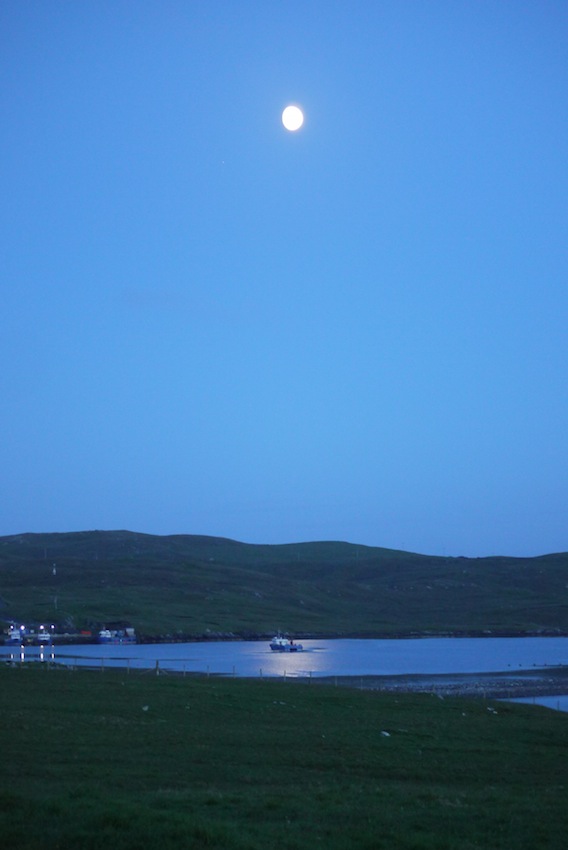 |
As I retreated into the tent for the night, my last image as I pulled down the zip was the simmer dim sky painted an unimaginable yellow, with the coastal lights of Yell twinkling in the gloom. Awsome.
|
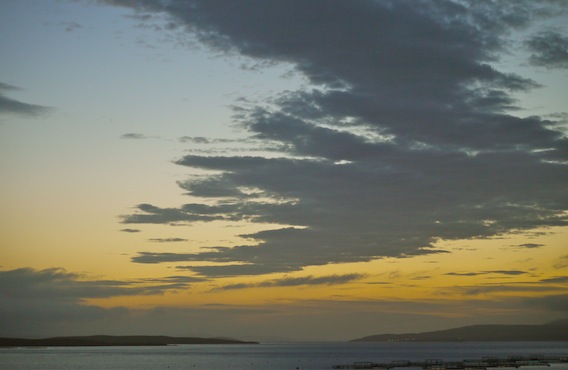 |
Day three
|

























